Here are some of the best guitar supports and rests I’ve played and reviewed. There are many types of guitar supports and footstools so it can be tricky to choose one at first or find the right one for your unique position. Guitar supports put the guitar into an optimal ergonomic position and allow for proper posture and playing angles. Having one foot up on a foot stool can strain the body. However, foot stools are not on their way out, many pros still use a foot-stool and I still recommend it for absolute beginners. If you are a beginner you should get a traditional footrest because everyone should have one and at least be able to use it: Foot Rests on Amazon.
The main options for supports
- Foot Stools
- Suction Cups
- Clamps
- Magnets
- Straps
- Cushion or Foam Riser
Bradford’s Main Guitar Supports
- Le Support (My Review) – My new personal favourite support. Le Support is the most secure and comfortable feeling classical guitar support I’ve tried. Not for everyone though.
- Guitarlift – Back Mounted Suction Cups. Great and fits more sizes and positions of players than Le Support. I actually recommend this support quite often.
- ErgoPlay Guitar Support – I use the Tröster model.
- Woodside Guitar Support – Clamp System. An important option for those who are sick of suction cups coming off.
Most Recommended Classical Guitar Supports
- Foot Stool – Still important.
- Guitarlift Guitar Support – My number one recommended support. Back Mounted Suction Cups. Also great and fits more sizes and positions of players than Le Support.
- Le Support (My Review) – My personally most used support. Back Mounted Suction Cups. This is my current favourite support that I’m using in my videos.
- ErgoPlay “Tröster” – Side Mounted Suction Cups. Very popular and I recommend it to students buying their first support. It is more likely to suit all players.
- Woodside Guitar Support – Clamp System. Works great, I use it sometimes. An important option for those who are sick of suction cups coming off.
- Sageworks (Barnett) Guitar Support – Magnets. A great solution but I don’t love the internal installation. Lots of people love it though.
Recommended First Guitar Support
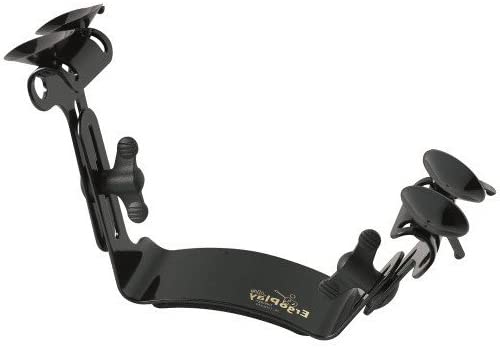
Ergoplay Tröster Support – You’ll probably end up trying or using more than one guitar support for various reasons. Everyone wants something different from a support. Some want it to be strictly secure while others want maneuverability. Some want a small support to throw in their bag, others don’t care about the size. That said, I’d recommend the Ergoplay Guitar Support (Amazon) as a starting point. I use the Tröster model and really like it but the Tappert model is okay too. The Tröster model is very adjustable, the suction cups are easy to use, and it’s readily available. I really appreciate the close angle it brings the guitar into my body, I just can’t seem to get that out of other supports. I don’t love suction cups but I need the perfect positioning of the guitar above all else. I use this in almost all my videos these days.
A note about suction cups: Keep them clean by occasionally washing them with dish soap and warm water. It really helps. If you have issues with air gaps in your finish try a non-adhesive protective vinyl material. I use a non-guitar one called Grafix ClingViynl. I’ve used it on French polish and polyurethane finishes but I’ve been told not to use on lacquer finishes so use at your own risk, ask your luthier or maker. Also, I often use a black cloth/foam on my right leg to keep the guitar from slipping, just a basic Shelf Liner.
Links to My Full Reviews
- Le Support (My Review) – My new favourite guitar support.
- Guitarlift Guitar Support – Also good, but I’ve switched to Le Support.
- HB Guitar Supports – Uses clamps instead of suction cups.
- Woodside Guitar Support – Clamps, more adjustable than Murata
- Z-Skinny Guitar Support – Stays on but with adhesive.
- Tenuto, Gitano, Murata, Sagework, Amy’s, ErgoPlay, Cushion
- Mundo Guitar Support and Strap – Back mounted, maneuverable.
- Review: Tenuto Guitar Support vs Gitano – Gitano is my fav
- Review: Sageworks (Barnett) Guitar Support – One of the best
- Review: Murata Guitar Rest Support (GR-1 and GR-2)
- Guitar Supports: Training Wheels for Student Guitar Positions
- Two possible solutions to suction cup problems on guitar supports…
Mentions (links to purchase)
- Gitano – Love it, compact, minimal, used it for years. So small that I always grab it for on the run stuff. But it comes off sometimes.
- Tenuto Slim – More adjustable than the Gitano and comfortable.
- Tenuto Lite – Four suction cups bit I still the like the above two better.
- Amy’s Handmade – Nice, and made of wood.
- Ergoplay Guitar Support – Recommended for students, I currently like the Tröster model.
- Murata – Love it, super secure. Doesn’t work on raised fingerboard guitars though.
- Sagework – Magnets, awesome design, great solution. The Apple of guitar supports.
- Cushion – Simple, bulky, but uncomplicated and it works. I can’t deal with it but people love them.
- Guitarlift – Bulky but feels great (see review below)
- HB Guitar Supports – Use clamps instead of suction cups
- Footstool – Reliable and secure, classic. I still perform with footstools.
Below is some older info from years ago but maybe still relevant to some people.
The Ergoplay Guitar Support (Most Popular)
Ergoplay Guitar Supports (Amazon) – There are a number of Ergoplay guitar supports out there and this is just one of the more traditional looking ones. The Ergoplay device fastens on via suction-cups. Get some static cling wrap (Suction-Cup Protector) if the tiny grooves in your polish cause reduced suction. These feel pretty good, places the guitar in a nice spot and allows the guitar to be movable. If the suction cup comes off on this one at least you still have gravity to help you compared to the Gitano et al. It’s the most logic choice for the average person so choose this one if you don’t know which support you should get. Recommended for students, I currently like the Tröster model.
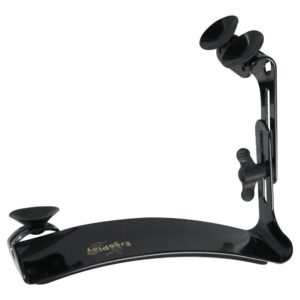
The Gitano Guitar Support
Gitano Guitar Support (Amazon) – The Gitano Guitar Support is ultra simple and low profile so therefore one of my favourite and most used supports, especially for on-the-run rehearsals etc. It also just feels more natural to me as my right shoulder isn’t elevated too much. It’s simple, small, and can fit in your guitar case. I love it for practicing but I’m too scared to perform with this one. If the suction cup comes loose there is no gravity to keep your guitar up, everything will crumble. It only rarely comes off with my static suction cup protector mentioned above. Still a great buy and I would buy it again for teaching and practicing. I recommend this as an option to have around but not as your primary support..
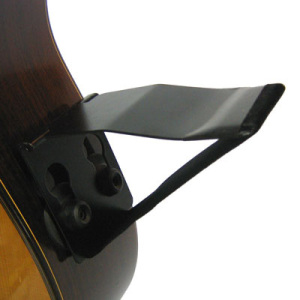
Tenuto Guitar Support
Looks similar to the above Gitano model but adds more suction cups. Sadly the one with four cups doesn’t fit my smaller guitar very well. I like how it folds over so it might fit in some cases. Order them from their website (tenuto.ca) via Calgary up here in Canada. I have two models from them, the Tenuto Lite (pictured on your left) and the Tenuto Slim. Also good is that the strap is adjustable so you can get micro adjustments going. PLUS, it has a pivot adjustment for angling your guitar inward to your liking. Depending on your guitar, two of the Tenuto Lite’s suction cups don’t always stay on as well as the others. Maybe because the wood of the guitar curves there is more pressure or not the correct angle on some of them? I really like the Slim though with their two giant suction cups but there is some flex to the large suction cup material that some people will not like. That said, it’s an awesome support and feels good, I’d be happy using it.
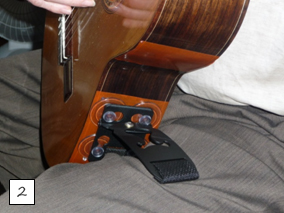
Sagework Guitar Supports (Barnett)
Sagework Guitar Support (Amazon) – Say goodbye to suction cups or clamps! This guitar support uses magnets to keep your guitar support in place. You can read the full Review: Barnett Guitar Support Here. Innovative and one of the best solutions with altering the guitar.
Pros: It will not come off in performance. Clean and beautiful aesthetic. Very adjustable. Great design and build quality. The cork will not damage your finish. It is generally cooler than the other guitar supports out there.
Cons: Maybe the adhesive thing. You might have to bit careful when placing and removing the support but you should with any product near your guitar. Otherwise, none that I can see.
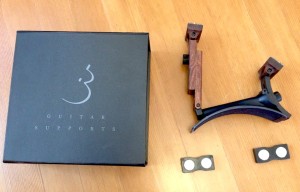
Guitarlift
See my full review here or buy from their site. I love the Guitarlift for how stable it feels and how I can get the perfect playing position. A solid guitar support that feels great to play. It’s on the big side but that is a small price to pay for something that works this well.
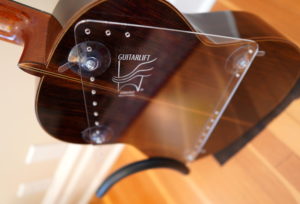
HB Guitar Support & HB Lite Guitar Support
See my Full Review Here to learn more or buy.
I’ve been looking for a trustworthy support for performance using clamps instead of suction cups for a long time. I used to love my Murata but because the clamps are so wide they don’t work on my raised fingerboard guitar because the top slopes down. Luckily, both the HB Support and the HB Lite support both work on my guitar since they attach lower on the instrument and the clamps are closer together. Read about the pros and cons at the full review.
Murata GR-2B, Guitar Rest
I’ve written a review of these: Review: Murata Guitar Rests (Ergonomic Guitar Support). Overall this is one of the better ones I’ve tried but I don’t much like the fastening device which constantly frightens me into thinking I’m crushing my guitar. Plus, if you have a raised fingerboard where the body of your guitar is not uniform then this is a pain. Here’s the quick of it:
Pros: simple, small, durable (metal all around), ergonomic sitting position, clamps are better than suction-cups
Cons: not highly adjustable (can’t seem to get a steep enough angle), heavy, the body of my guitar is not an even width due to my raised fingerboard so I had to place foam supports on one side to make it work. Might wear down my french polish. Comes off sometimes. However, if you have a normal guitar it should work very well.
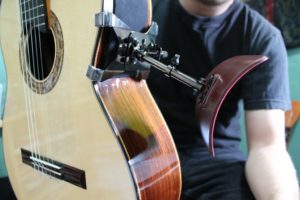
Dynarette Guitar Cushion
People seem to love the Dynarette & Other Brands of Guitar Cushion but it’s not for me personally. All I can say is I don’t like the idea of having a loose object sandwiched between my guitar and my leg. I want to move the guitar up and down and side to side and not worry about loosing the cushion. Plus walking out on stage with it could be awkward. And it I think it looks dumb. It also makes squeeky sounds against the guitar polish. There should be a Seinfeld episode: “The Cushion”. Nevertheless they are popular with everyone from professionals to students and I think it’s a great solution for practicing. It’s also super simple so WILL work.

Also see these specific reviews:
- Review: Tenuto Guitar Support vs Gitano
- Review: Barnett Guitar Support Here
- Review: Murata Guitar Rests (Ergonomic Guitar Support)
- Guitar Supports: Training Wheels for Student Guitar Positions
- Two possible solutions to suction cup problems on guitar supports…


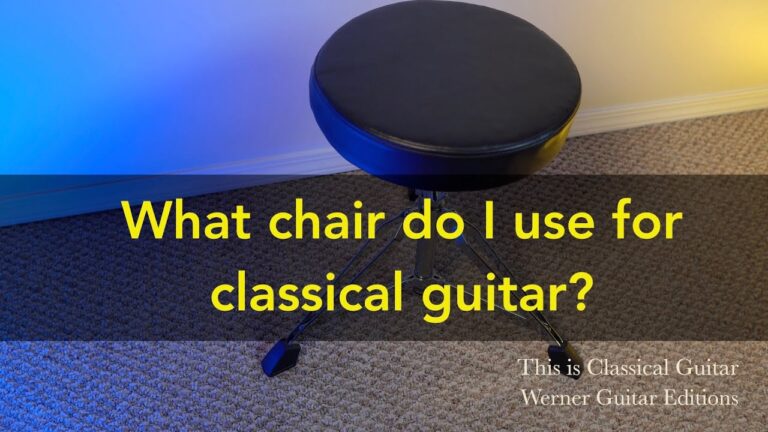
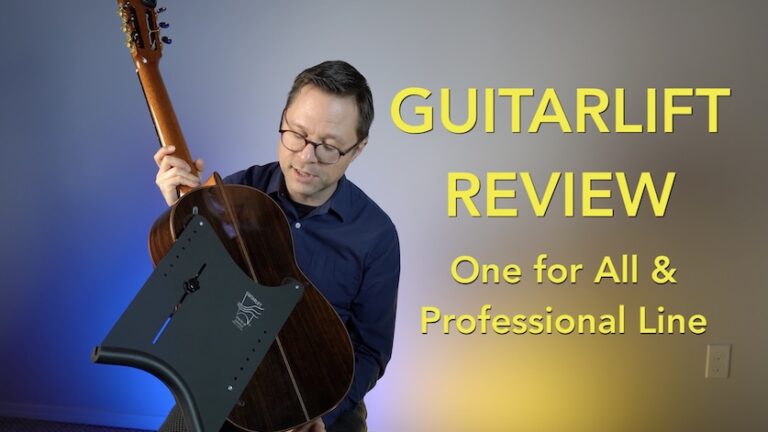
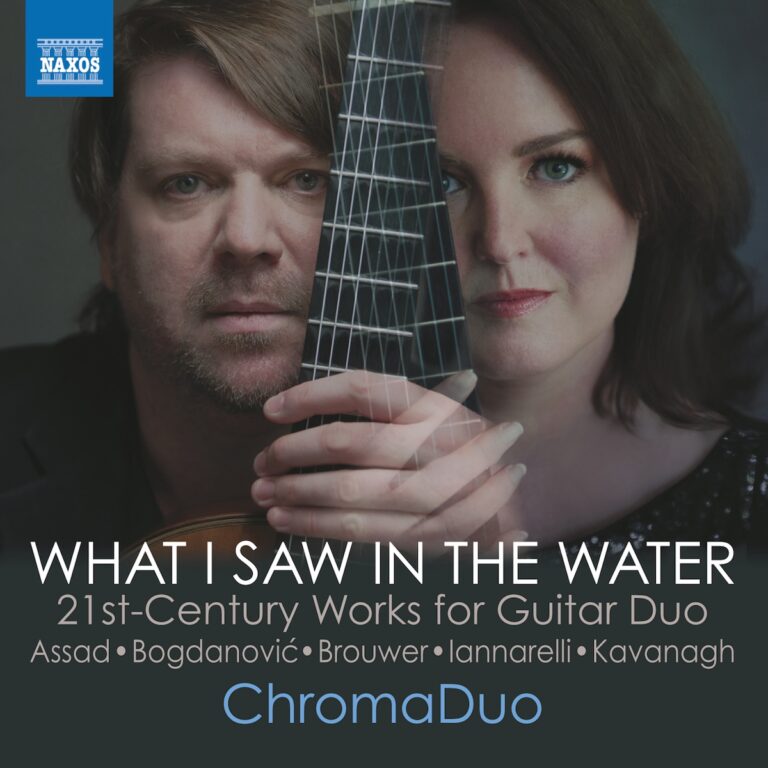
I play steel string acoustic stood up most of the time but have just bought a Godin Grand Concert for a project. Is there a support that will attach to this thin style of guitar?
You might consider the GuitarLift, you could write them and ask.
GuitarLift doesn’t seem to be available any more? Website link bounces back
Thanks, I’ve updated the link to their new address.
These comments should be separated for home use and stage performance with maybe another for lessons with a teacher in another building away from your home. What percentage of playing is done at home compared with stage or lessons ?I would say most is done at home. The people who can use a footstool without constant pain can try any design they like. Some use footstools and also supports attached to the guitar .
A separate discussion is needed for the players in pain and who dislike footstools. Why have them all jumbled up together ? The lucky ones do not need to boast about their physical perfection and freedom from pain . Everyone gets old and age is all about dodging pain when possible .
So back to my idea about a stool (at home ) for two feet on the ground and an attachment to the stool which will mimic the shape of your leg with plenty of adjustment for angles . The stool will have no back so the approach to the stool is not awkward. No climbing over the “obstruction ” which will be the guitar support . Just hold the guitar in one hand as you sit. Lift the guitar onto the padded rest .Work out how the guitar balances ,if the neck end is heavy ,and create enough padded support in the right places. This stool will obviously not suit a player who wants to travel the world with stage performances .But being world famous is not the only reason to play a guitar. Once it used to be just a way to get the chics . One is unrealistic and the other is flippant .But being free from pain needs more than a good review and a nice price . Lets all concentrate on the painful bit for oldies .(Like me . I`m 76 ).
Well, here’s some you haven’t tried: https://www.deoromusic.com/deoromusic/Guitar_Support.html
UPDATE: I have been using the Gitano support for the last several years and now prefer it to the A-Frame. I am able to get the head/neck even higher with the Gitano.
I still enjoy reading all the contributions to the comments of this article over the years.
Reading this whilst sitting at the table with my guitar in playing position firmly held with a strap, fitted in the conventional way – button under the heel and an end pin. Comfortable, unproblematic, secure, adjustable, can be tilted into many other positions, guitar firmly held but body relaxed.
It was such a relief to get away from inconvenient, tense, artificial, masochistic, foot stool.
Is this whole topic over-thought, dominated by fashion, obedience to guitar gurus like Segovia – and the desire to avoid looking like a mariachi?
I might go in for a decorative strap with tassels and look even less like a “serious guitar player”.
I also tend to use the right thigh as a rest but find that I lift it with toes on the ground but heel in the air – still more comfortable than a rocky little footstool.
I think one needs to be able to adjust body and playing position frequently, and locking into one position could be the cause of a lot of aches and pains.
I have been experimenting with different strap layouts . The guitar I bought had one button screwed at the neck curve on the treble side. Fitted a bit wonky too . The other button was at the bottom and I questioned how a guitar would like that inside a guitar case That would cause some stress with the case held vertically
That layout would have the strap behind the right shoulder Similarly if you tried a lute strap fixing where the left side of the strap is attached near the tuners Both those seem to be claustrophobic or too loose. There is not much between those two supports
A different way was just using the neck curve button and a loop of strap around the neck The strap stays in front and hangs the guitar in a nice balanced position Many guitars have different centres of gravity That is my latest attempt but I need to steel myself to drill holes in the other guitars . I have never done that myself .
Two thoughts about chairs . I saw a very low chair in an antique shop. My wife said it was a nursing chair. Padded Victorian style and no arms to get in the way . It was so low you could touch the floor without leaning sideways . Good thinking if you fall asleep and drop the baby . The knees would be at a good angle to rest the guitar without slipping.
The other chairs I considered are folding garden chairs with the seat and back made of a thin mesh. That does not cause any pressure points where you sit. This mesh adapts to the body shape .
Reading through the older posts I feel I should apologise for rambling . If I think of any amusing ideas don`t think I am not seriously interested in a good result . It must be a worry for frequent stage performances .
Leon I have seen a youtube video by John Willams and he analysed why Flamenco players have one position and Classicals a different one .The fingers on the strings need certain angles and positions to work most effectively . See if you can find that video .
I’ve made quite a few comments in this thread, so I thought I’d add an update. I have switched over almost entirely to playing with a strap, at a very steep neck angle with the headstock slightly above eye level. My back and left arm problems have progressed, and made things more inconvenient; but I was watching some video of great jazz guitarist Steve Herberman, who uses an extremely upright cello-like angle with a strap. I realized that this steep angle might be more viable for me, and so I have adapted to this approach. The guitar rests between my legs, touching both thighs, and is primarily supported in position by the strap. The guitar is pinioned between legs and sternum and right forearm. The strap keeps the guitar from rotating or slipping. So my Dynarette cushions are back on the shelf, and my footstools are more or less unused, except when sitting on a high stool, in which case I bring my feet up to what would be floor level on a normal chair. This is working well for me.
I’ve had really bad RSI in the past using footstools and an ergoplay support. I bought a Gewa Gitano Gitarrenstütze about 4 months ago and the instant i put it on and tried it I was delighted. Perfect posture and support are possible giving complete freedom of move.
Couldn’t be more pleased.
I sit in the Flamenco position to play classical, and it works like a charm….Ricardo Gallen does as well….
A few years ago I bought the Oasis one… actually I bought two because the device that secure the suction cup broke. Later on I bought the guitar support that have magnets and I still use it. 🙂
Hi all, thanks Brad and everyone for the discussion and reviews. I just ordered the Gitano from Stringsybmail, so I’ll see how that works out. I had previously ordered an Oasis small foam support, but I don’t like this at all- it slides around way too much. Honestly, what has worked best for me is to play in my living room chair, with the ottoman in front of me, resting the guitar on the ottoman, sort of like the Tripodium that Aguado devised! I also play violin and have a Kun rest, so the Murata also looked interesting to me, but for cost purposes and since it’s Brad’s fav, I ordered the Gitano. I’ll let you all know how I like it.
There seems to be now a Gitano Guitar Support with 3 suction cups. It’s called “Gitano Guitar Support 2017”. Haven’t seen many places who sell it, at least Thomann has it.
I scrolled through couldn’t see anything so sorry if this has already been covered.
What is wrong with a strap?
I’ve tried various alternatives;
the foot stool is the most inconvenient,
crossing legs works except for the loss of feeling,
the Flanger with suckers is good but can pop off spontaneously – might take a bit of varnish off too?
Now using a strap. Buttons in the usual places – mid bottom and on treble side of heel.
This seems ideal – easy to adjust to the classic position and it stays in situ with hands off – the two ends of the straps are close to straight up and down so there is little tendency to swing around. But you can easily adjust to another position, depending on what you are playing.
Slightly mystified as to why they are deprecated on a classical guitar.
Jacob you have a good case with straps. One solid reason for straps is when reaching out for sheet music or even just standing up . The guitar will come up with you and not suffer some random collision ..The guitar is a slippery thing and we only have two hands . Maybe the idea of screws being drilled into the guitar by players would be less of a problem if the makers fitted neat brass inserts .No guilt feelings needed then.
Mexico has plenty of guitar players but we have not listed the strap around the neck which comes under the guitar and then hooks into the soundhole. Hopefully it has some padding there .Maybe a bit rough on the most sensitive part of a guitar .
The visual impact of a strap seems to repel anyone who wants to “look” like Julian Bream .But if John Williams got a strap the problem would vanish .Image is the new reality and we need to fight against it.
Steel string players use straps. Is that the root of this question ? Let`s be different from them?
Appearance can put you off . One thing that puts me off is affectation in the face pulling way . Expressions that too obviously look as if a player has just entered Heaven . All kinds of in between hand movements meant to show sensitivity etc etc .Is there a correographer to write all these extras down . Ballet teachers show how hands and fingers should move for a graceful effect. But it`s out of place when a musician starts it too . It`s a version of Air Guitar I suppose. Steel players can do it and still look Hard . But it`s still Daft .
What do you think about the Shearer classic guitar strap ?
For me, the Shearer attachment methods are totally unacceptable. Eye screw? Velcro? No thanks, not on my beautiful guitars. I use conventional strap buttons on most of my working guitars, and this approach is adequate when standing or for a little extra support while sitting and using a Dynarette cushion. (As I said above, the Dynarette was what let me resume playing after a long hiatus due to back problems. It’s the only real solution for my particular body configuration, although it’s not ideal.)
Aguado was on the right track there .He wanted the support to take away the puzzle of securing a lopsided , slippery weight . In the victorian era a toilet would be flushed with a clanking water container high up on the wall with a chain dangling down .Today there is a different approach .Hide it away and pretend it`s not there . Problem? What problem. The audience cannot see your discomfort so it does not exist . That`s why these instrumental aches and pains are never solved .We have raised the bar too high .Be ashamed of your problem .This is the modern theme .
But a survey of guitar chair designs provided by impressarios might give us a clue to the fixing methods we could evolve to hold a vertical pole strong enough to hold up the end of a guitar . Maybe bring on a cast iron street lamp , Art Deco ,with a convenient curved arm to complete the ensemble. A cheeky tilted trilby hat would match the scene. Cigarettes would be optional
But what is a guitar chair? Is there such a thing? I saw a picture of a guitar factory yesterday with endless rows of unfinished instruments in long rows .Just a few years before the wood runs out we could wake up a Rip van Winkle chairmaker and tell him what we need .
Imagine a sunflower in front of a tasteful curtain concealing the pole and all the audience glued to the mystery behind it. “Watch the sunflower children and tell me me when it grows”.Who needs music with that kind of excitement ?
Very amusing ideas. However, for me at least, the problem would not be solved by a static guitar holder. I must move around a good deal when I’m playing, and I’m pretty sure that having to wrap myself around a fixed instrument would not work for very long. I think all of our support options involve tradeoffs. I do agree that we can and should do better; but I’m sure that there won’t be a “one-size-fits-all” solution. Our body geometries and idiosyncrasies, our playing techniques, and the physical demands of the instrument (involving very different approaches to the top and bottom of the neck) ensure that somebody will hate every solution, and everybody will hate some solutions.
This question is like a daft game you can play when you ask “Guess what number I`m thinking of between 1 and 10 “. So you guess and the answer is “Wrong. Do you want to try again ?” There will never be a right answer. If we got very close the questioner with a guitar will turn out to be a trapeze artist wanting to play in mid air and won`t want to drop it . Is that right? Wrong ! Want another go ?
The game was “How do you hold a guitar ?” IE sitting still on a chair . Not standing up . Not moving around . Start again .
I think the ideal would be one of those large cane sofas where you are almost laying down. Then the guitar cannot have it`s wicked way and commit suicide by ending up on the floor. There was a Suzuki motorcycle made once with brand new disc brakes .They were not fully developed and the label stuck to the tank said “Do not ride this machine in the rain”. The pads were changed later with copper in the material .(True).
So a simple label on a guitar “Do not play this instrument unless you are laying flat on a sofa “.
Sofas with wheels ? Good game .Not frequently asked question —“Can guitarists ever play on a sofa ? ” The phrase Sofa /Guitar has probably been promoted to a dictionary .
This is getting quite convoluted, nothing wrong with experimentation and personal preference.
John Cadd, you again make some amusing points but I don’t think this discussion has been fruitless. I at least find it helpful to know what other people have tried. FYI when I say I move around, I don’t mean I walk around the stage, I mean I can’t stay rooted in one fixed position on the chair, or my back goes berserk. I need to keep shifting my angles. I also need to change my posture when I go high up on the neck above the body join. I don’t think either of those behaviors is unusual. That’s why a rigid guitar stand hasn’t worked too well for me. YMMV.
Oh we are getting closer then. For a moment I pictured one of those Mexican Marriachi Hooks that fit round the neck and then come under the guitar and come up to hook inside the sound hole. That must be hard on a nice guitar . So replace the leather with elastic at the tuning area and a swivel to follow your movements. Still mechanically simple and bombproof. The feet can both be on the floor .The footstool can grow to become a nightmare monster if you think too much about it . Maybe the idea of it suddenly tilting sideways could become a new phobia . Maybe elastic is not serious enough for serious music. Elastic does all it can to adapt to our wishes and we spurn it`s efforts to help us .
Let us try (both of us ) to separate the elements of holding a guitar. The left hand is required to hold the neck up as well as finger the notes. We should not expect the neck to support our left hand .It`s important to spell that out first .
The guitar is a large thing and we need to look at what different parts are liable to do. Look first at the top of the lower curve .Some guitars have an extra protective cover for the edge (or for the right arm comfort). We may get used to using it as if it`s an arm rest on a chair. The rest is not to protect the appearace of the edge as we cannot see it with a cover on. So how does that contact interact with the player?If the arm became uncomfortable then there was maybe too much pressure being placed there .That would transfer to the bottom of the guitar where slipping can begin . The right arm will generally be a secure enough controller for the top edge of a guitar .The bottom of the guitar will tend to slip outwards as the top is held in .The guitar body is not held exactly vertical so the bottom side will contact the inner guitar edge against the right leg. If the leg surface is “horizontal ” there may be slipping as the guitar bottom ( side) will not match this angle of the leg.
So most control is made by the left leg in a raised position for the guitar side to have a stable neutral contact. Neutral means the planes of side and leg mostly match their angles . So where is the problem in this position? There will still be some sliding effect along the guitar length if the guitar curves do not hook onto the left leg (as it were ).(so to speak ).This would require some type of grip (non slip ) surface either at the hook curve or at the right leg contact.
Out of those elements of a guitar hold which ones cause the most trouble? Let me know if I have left out anything. The footstool here is being used for the time being as a starting point. Any change from this is allowed but must be explained and reasoned through .
There is a type of material that will not allow shiny varnished surfaces to slide and which is not sticky is not velcro and does not use suction .. Would that be of interest ? That may be new to you .
Let me see if you have a clear ,precise understanding of why you are unhappy with your guitar hold . Left hand ,right arm ,right leg ,left leg ,your body ,the guitar`s body . Contact with the seat , spine alignment ,ischeal tuberosities all come into this. Even perching on the edge of a chair (ouch) can make you numb .
Sorry John, but your comment: “The left hand is required to hold the neck up” is incorrect! The left hand should have no part in keeping the guitar in position.
Yes, agreed. The whole point of traditional classical guitar position (and alternative improvements) is to anchor the guitar so that the left hand is totally free.
So left hand is eliminated from the subject ? What does that leave us ?
If you sit on a chair with both feet on the floor the thigh surfaces ,although not flat can be relatively flat if the chair matches your leg size .Already a variable has crept in .Worst would be a higher chair that allows the guitar to tilt and slide forwards . One simple element of the equation .
Where is the centre of gravity of a guitar? Does it vary from one guitar to another? Will the lengthways tilt of a guitar unsettle that fine balance without any help from the left hand ?
Feet on the floor time now .Some kind of support at the lower curve is needed .A shaped pad or cushion?Or a frame which is as invisible as we can make it .Completely invisible would be perfect .Cushions or pads tend to slip /roll or squirm out of position. One way is to fix it on the guitar. The other way is to attach it to the player or to a mythical object called a guitar chair . Unless it is invisible the player will need to haul it on stage and set it up first .
If you had a word with the management they could pull back a curtain when you are ready .No uncomfortable walking out on stage beforehand .
Ask questions till you are blue in the face and total resistance to every solution will be the result .
Thanks again for your detailed thoughtful comments. I should begin by saying that the whole point of this give and take has not been (in my mind) to present arguments or refutations or problems, but to air the issues. I think this has been successful. We’ve addressed a wide range of guitar support topics.
I did not view this as an exchange of “please suggest…” and “…no that’s not right because…” posts. It may have seemed that way, though. But I really wasn’t criticizing your suggestions, but just providing feedback. You’ll see that I have been chiming in on this discussion for a long time, because the issue is very important to me, and because my particular point of view sometimes gets overlooked when manufacturers consider user requirements (sometimes by looking at threads like this). So I try to pipe up whenever the topic appears.
My specific situation is unusual although not unique. Since you’re asking about details, I will mention that I cannot use a normal footstool configuration, because that causes my body…to explode, It is why I had to stop playing for ten years. So this is not a trivial matter for me. I am quite aware of the various nonslip materials you refer to, and they are helpful, and I’ve tried many of them, along with many of the other approaches discussed here. (Some of the nonslip pads dissolved my guitar finish, despite promises to the contrary, so be aware that those sales claims are not always to believed.)
In my particular case, I have experimented with many supports in an attempt to come up with a comfortable, efficient position that I can use for my normal work (often 5+ hour gigs, several days a week…so the solution has to be really effective).
As I’ve mentioned earlier, the most practical (for me) has proven to be a low footstool plus a Dynarette or similar cushion. It’s not ideal, but it works for me. Lately I have been anchoring the cushion with cords that attach to the guitar’s strap buttons (on those instruments that have strap buttons); and this is helpful. Occasionally, I use a normal strap, either standing or sitting, and when sitting sometimes with stool/cushion and sometimes not.
I should add that a robust stool has been very important. I’ve settled on the K&M stool plus backrest (http://products.k-m.de/us/Drummer-s-ThronesBenches-and-Stools/Stools/14046-Pneumatic-stool-black-fabric) as the most effective for my own needs. Lumbar support is critical for me.
Another theme in my comments has been that suction cups, adhesives, and other things that might damage a valuable instrument’s finish are not of interest except when I’m playing a “beach guitar.” Most of the commercial solutions use these, and they’re great for many people. But I remain in search of really good alternatives for stabilizing a valuable instrument that don’t require me to elevate my left leg (much) nor assume a too-rigid position nor involve altering or risk damaging the guitar.
I think that the “Brahms Guitar” cello-like approach is probably closest to my ideal; but of course this doesn’t work with a conventional instrument. I still think that a better device can be designed than what we have today, sort of a hybrid between a cushion and a Barnett support — one that provides a mix of stability, adjustability, safety, and comfort; and I’ve put some thought into how this might work. But we’re not there yet, and my particular set of problems are not so common — I don’t think anybody is going to build them for me. But I pipe up in case it happens. I’ve been wrong before.
Thanks again for your helpful suggestions and comments. I really don’t think this is a question of my rejecting your ideas, nor of your ignoring my needs. It’s a complex problem, and it needs a lot of discussion. I expect that some readers will find what they need from your suggestions; and that others will see my comments and realize that they might have some problems using the standard products.
I tried to make a guitar support which clamped to a wooden dining chair . The makeshift best was clamped to the left side . The idea was to make a support pad to copy the shape of my left leg.If the only thing being supported is the guitar it would not need to be tremendously heavy .It could allow some movement and flexibility for a natural feeling. That would rely on support below the curve of the body .
If you want to avoid guitar body contact maybe there is a way to look at the tuning area and (half ) suspend the guitar from that with the guitar simply resting in your lap and the arms controlling the position. How would a flexible curved pole clamped to the chair leg feel . It could have useful kink in it like a ski pole . Attach with a leather strap loop through the tuner slots.Just sit down , hook on and away you go.
There was a Victorian reading support on tv yesterday .Made of brass tubing with adjustable joints to hold a book in place. Inventive Victorians could have sorted out this problem years ago . There might be a design hidden in a library somewhere .
Well, there’s Aguado’s famous design: http://www.maestros-of-the-guitar.com/images/tripodion.jpg
Do we need a short hand way to define the different guitar positions that we can see these days? The upright John Williams position tells us of his violin training and friendship at college with violinist Alan Loveday . I think I`m right about that . Nice straight tendons in the left hand . Straight back and neck too .Julian Bream had a slightly lower intense relationship with the guitar shape .But derogatory comments about the appearance of a rest have a negative effect on possible solutions .Nothing is set in concrete but many people are too keen to reach for their shovels and start to load the ingredients into the mixer.
I can add a different element to controlling a slippery guitar but I need to work through a few details first .I will always avoid footstools and suction cups though .
I would like to introduce you to the the most simple and effective support,- the Guitarlift…
It’s hooked at the back, has enormous stability and looks cool too.
Already chosen by many players. Such as Margarita Escarpa, Dr. Eva Beneke, Thomas Müller-Pering, Jozsef Eötvös, Michael Langer, Kostas Tosidis, Johannes Monno, Paolo Pergoraro, Arturo Tallini, Woody Man
And many more …
Check it out ….Guitarlift.de it’s available in transparent and black …soon in transparent black as well…
Interesting, but as stated above, I have zero interest in a support that uses suction cups.
How about a bespoke (classy ?) chair that has a swivel support from the right side to support the guitar?
Sit on the chair –swivel support in front and place guitar on support.
Adjustable parts to suit any instrument . Pivots , hinges and catches have already been invented.
Seat is used as per normal and will not twist the spine .
I’ve been looking for one of these for some time. I haven’t found a design that really works. In my case it absolutely must be easily portable, and just finding a well-designed portable chair is hard enough. Adding the guitar support is another whole level of complexity. But if anybody does this I’d sure be interested.
I am short, and use the Dynarette because my lower back tells me it has had enough of footstools. (I have been playing pretty regularly since 1969). I use a “grip mat” both under and on top of the Dynarette to increase stability, and also to stop it squeaking, which can be audible in concerts during quiet pieces. Combined with yoga and Alexander Technique the Dynarette keeps me playing and performing at 59.
Hi all, I’ve tried the dynarette cushion after years of using a foot stool. I have to say the cushion is a real disappointment. It does not offer enough height on the guitar (even though) I am by no means tall. I also use the “large” cushion. The angle of the guitar is too low to comfortably play anything from the twelfth fret upwards. Lately I find that I use it in conjunction with a foot stool, which absolutely defeats the entire purpose! This thing sucks, and it doesn’t even have suction cups!
Interesting. I also use it in conjunction with a (low) footstool. By doing so, the cushion alleviated my extreme spinal problems, and allowed me to resume guitar playing that otherwise had become impossible. I do agree with you that the cushion is not ideal, and I found that some experimentation was needed with choice of chair, elevation of feet, angle of cushion, etc. But in my experience, the cushion has proven the best and most useful solution. I guess as usual, “Your mileage may vary.” I am a full-time musician playing 200+ performances a year, so for me it has been a lifesaver.
I’m concerned about succion cups. I bought Gitano and let it stuck on my Martin custom shop guitar for a few weeks. Very bad idea: the plastic from the succion cup react badly with the guitar polish !
Egad. This is exactly my fear. I have simply reverted to using the Dynarette. I could never bring myself to install the Barnett magnets. I got the Murata, but found it unsuitable. Still hoping for a better mousetrap. Of course there is this approach: http://buildingtheergonomicguitar.com/wp-content/uploads/2010/03/Ergo-Acoustic-Guitar-Closeup.jpg
Thanks for this excellent discussion. i have been using the Dynarette for several years — it allowed me to resume playing after a 10 year hiatus due to back issues. Thus far I have been unable to find a good alternative; I really don’t want to put a suction cup on my good guitars. I perform several nights a week so I need a solution that can be installed and removed easily and frequently without damaging the finish. I had dismissed the Barnett based on a first blush reaction, but your review has convinced me to try one, if I can find one. They seem to be out of production at present, presumably because of the shortage of rare-earh magnets. Like you, I am also concerned about the internal adhesive. If it is not strong enough, the magnets could detach during shipping or transport, which would be a disaster. If it is difficult to remove, then the guitar is permanently altered and that has various negative ramifications. I am not concerned about acoustic effects (Torres showed us that the back and sides really don’t impact the guitar’s sound) and the strong magnets certainly won’t rattle. So on balance it seems worth the try, though applying adhesive to a hand-made guitar always gives me the shivers.
A company call Kling-On makes static guards that won’t hurt french polish. A good option that I use.
I have been using the Gitano for many years but on my new guitar i have just noticed it has reacted with the lacquer causing it to come off. My luthier thinks it is because the lacquer has not had enough time to settle in properly but i am going to try a cushion asthis seems to bethe only one that won’t damage the finish. The Dynarette seems to be the one everyone uses but for only £11.99 instead of £35 there is one on Amazon called the Anself Contoured Guitar Cushion so might try that first – has anyone tried it?
I haven’t – I really like the Dynarette – but would be very interested to hear more about it when you have tried it.
A-Frame Guitar Support is the best I have used, but the suction cups could be much better and in diffrent sizes. Make it better and we have a wonderful choice. Dynarette Guitar Cushion are nice for practice.
I bought the A-Frame a few days ago. I had never used any support before but my back was starting to act up with the footstool.
Well, the A-Frame didn’t work at all. The suction cups come off too easily, I was never able to keep them on for more than 15 minutes no matter how I place them and how hard I pressed them. I will have to find something different. Maybe the Neck Up, Dynarette or Murata. No more suction cups for me.
I highly recommend getting some static cling wrap (plastic) for the suction cups. Many types of polish have tiny grooves where it has soaked into the wood and where air pockets exist and will not allow suction.
Here’s a link for the suction protector: http://www.amazon.com/gp/product/B00AWTY5U0/ref=as_li_tl?ie=UTF8&camp=1789&creative=390957&creativeASIN=B00AWTY5U0&linkCode=as2&tag=clasguitcana-20&linkId=GRZQXJQ2UZB2E65Z
Thank you for the information. I have ordered one from Strings by Mail, as the Amazon price is outrageous.
I have a Dynarette which I like. I reduced the slippage problem by adding a Velcro strip on the pillow on the side that faces the guitar. Guitar and pillow are attached to each other, eliminating some of the slippage.
Thank you for this article. I had my first lesson today and know that the footstool is going to kill my back (I’m 68). Haven’t decided which option to choose, but this will make my researching a whole lot easier!
Glad it helped. I’ll be doing a part 2 soon!
Regarding the new one, “Kris Barnett Adjustable Magnetic Guitar Support”, if you go to stringsbymail website and check guitar support section, this is being sold there for $96 and there is a video that clearly explains how it works. I have not used this, so am not best judge here. My experience with guitar support is only a small Dynarette cushion that I am not happy with. It is not adjustable and guitar slides on it, and is short for my taste.
Back to the Kris Barnett, based on the video, this device looks sturdy, very adjustable and reliable. But firstly it is too expensive, secondly you have to stick the magnets inside your guitar which is a bit scary as to if it might damage the wood, although it is apparently using a safe and easily removable adhesive, thirdly I don’t know how much the whole thing weighs, it seems to be rather heavy.
My gut reaction to this was that it looks too big and clunky. When s guitar maker spends so muvh time snd expertise producing the instrument he does not anticipate someone tampering with the inside.I would expect some kind of non musical reverberation ftom it!
You should check out the Barnett magnetic guitar support.
Just bought a new Flanger on ebay for $11.20 free shipping.
I have been using a dynarette (see previous comment). Unfortunately, I have had some back and left arm problems, including tenosynuvitis and a bursitis in my elbow. I think these are age related, (57) not connected to using the dynarette. I am experimenting with playing the guitar the other way around to balance out my body, and because it’s a very interesting intellectual exercise. So far it’s going well, but I can feel that my back really doesn’t like the footstool. Does anyone know of a guitar cushion made for left handed players?
The video and discussion has been very helpful. It has helped me choose an ergoplay because it adjusts both for height and orientation of the fret board – making it easier to see than many other choices which do not allow for that. Brad, FYI, I wanted to order this through Amazon so you would get a fee, but Amazon does not ship this product to Canada. Ordering direct from Ergoplay would cost $35.00 for shipping. Has anyone found a viable alternative?
Hi Lari,
You can order it from the US via Strings by Mail but also, very likely, your local music store. Don’t worry about the Amazon thing, no big deal for me…
Thanks, Brad. For the benefit of those following this thread, I couldn’t find a local music store who carries Ergoplay.
Well, it depends on where you live, here in Victoria I know Larsen music carries them…
Hello. Great website. I just wanted to express how grateful I am for you guys having this information up. I’m 18, have been playing guitar for 8 years and have been concentrating on classical for about 4 years. At a young age it’s funny to be concerning about back problems and in doing is I discovered with the help of my chiropractor that it was due to the footstool position. I have no information to share, since I was looking precisely due to my problem, but now I have a much better perspective about where I should be headed with my guitar support purchase. Again, thanks for the information and I am looking forward to share my experience and being a part of this community.
I have been using footstools, ErgoPlay and for the last few years the Neck-Up which I found the best, and easy to adjust, handy when playing different guitars, using different seat heights, or wearing different heels! The only negative to report is the suction cups which can come off, though in my experience only with one of my guitars, which I suspect comes from the finish lacquer. Several of my fellow players and students use the Neck-Up, and all rave about it.
Great website by the way, most informative. Thanks.
This is an intersting discussion.I started classical guitar as a complete musical novice.I started out with a footstool but found Iit uncomfortable and was persuaded by a different teacher to try an ergo.I liked it immediately.It seemed to really help me but after approx 10 years of 3 hours practice a night I developed aching and burning in my upper body worst of allin my forearms.I stopped playing for 7 years and have recently started playing again, determined this time to avoid injury.After reading your article I have been reassessing my posture and the effect of using the ergo.I realised that in my attempts to prevent slippage of the rest on my knee or the suckers on the guitar I have been inadvertently tensing up all the time as I play. I have discovered that by setting the ergo at about a 60 degree angle and allowing the guitar to sit 4 inches further forward than what seems to be the usual position I have complete stability and am able to use gravity to advantage whereas before I was fighting it.I can’t help wondering if this has been the source of my injuries and pain?
Wolfgang Fritz
I use Hagi Rest http://www.hagi-guitar.com It really works great due to 3M glue technologie. After half a year I removed the glue pads for control, no glue on the nitro lacqeur at all.
I made bad experience with suction based rests.
I use a ‘Gitano’ support, which suits me. It is small, attaches with two suckers, and folds flat– so you don’t even need to take it off to put the instrument in a normal hard case. I always hated footstools as too cumbersome to carry round, and the same goes for all those big ‘frame’ things that attach in various ways. I’ve tried the EFEL, which doesn’t fold flat, and relies on a single sucker (not a good idea).
Thanks for your input Neil!
HI Guys! I’m a classical guitarist from Perth Western Australia – been playing since 1969 & teaching since 1974. Have battled with upper back problems & R.S.I. & am in consequence a fully trained Alexander Technique Teacher as well. At the age of 56 found my lower back didn’t like a foot stool any more. Have already tried various suction type supports – no freedom of movement and made my shoulders very tense. Now have a Dynarette and am able to practice without pain – more mobility and security than a footstool. I have a short torso, which may be why the other devices didn’t suit me, but with the Dynarette I can alter the angle of the guitar any way I want (for high position work or artificial harmonics) and it doesn’t budge – i also use a “grip mat”. but the sticky strip on the bottom is really sticky – as an added precaution, you can wear velvet, cords or bare legs. I love dynarettes.
Hello Jane – I had a few lessons with you in the 80s but only recently started having postural back problems with a foot stool.Your comments are interesting.I will try a dynrete but the Mutara looks sensible! best wishes, John Spencer (now 77)
Hi Joh! Good to hear from you – I think I remember you; did you live in the hills? Let me know how you go with the Dynarette. My physio likes it; some other guitarists in Perth really like them, some don’t…
No, Lived in Applecross, Heathcote Hospital Super. One of our patients was a competent player.Look after your spine! John
Wow, that’s a great contribution to this article Wesley. Thanks. Another vote for the A-Frame, I’ll have to try it out.
I am older (67) and have serious back priblems so i cannot use the footstool. I’ve used the cushion (large) but did not like it: it falls off; does not give enough rise for upper bout so I still needed foot-stool. Used something similar to the EFEL and the Tenuto, but it didn’t support the upper bout AND the suction cups would fail. My teacher uses the Neck-Up support and it’s ok but difficult to get the adjustment I needed. So so far, the support that works best for me is…the A-Frame! I like the way I can adjust the angel of the neck and the placement to the left or right. And the four suction cups are secure.
Interesting Bruno, I should try it out as I didn’t give it the best review here. Thanks for sharing!
I have also tried the ErgoPlay and found I like it the best. But there is a big problem with the suction cups leaving large marks on the finish. Beside being unsightly, the roughened surface then causes the cups to not adhere to the guitar.
Thanks Bruno, I am in the same boat (figuratively speaking) as you – age, problems etc. I am going to give it a try. Tony
I use a Tenuto support that is made in Calgary here http://tenuto.ca/
Thanks Tom! I’d add it to the list. I like the four suction cups…extra protection…
My favorite type is the Ergoplay Tröster (Fully Adjustable, 4 suctions cups)
In second place the Murata